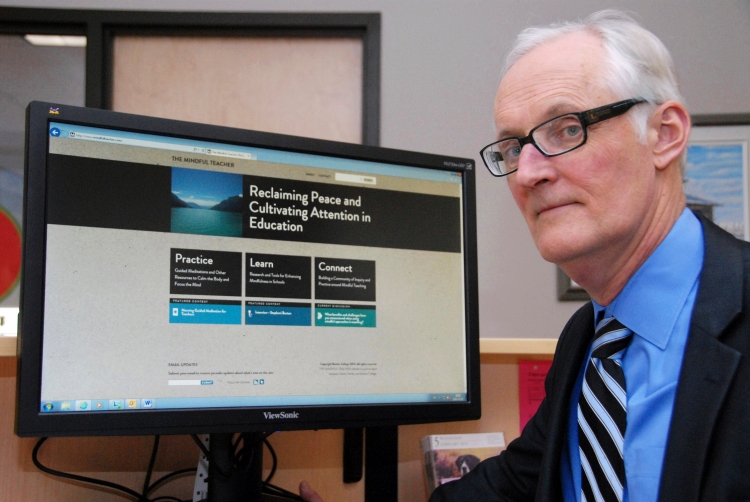
By
It’s hard to reconcile the boisterous realities of the typical classroom with a quiet space, the chime of a gong, meditation, and an unhurried dialogue among teachers seeking to make sense of the joys and the challenges of teaching.
But Lynch School of Education Professor Dennis Shirley – whose research has placed him at the forefront of the educational “mindfulness” movement – thinks that teachers who can retreat from the schoolhouse cacophony to reflect on their experiences and those of their peers can energize and improve their teaching.
“Mindful teaching can help us to calm our bodies and focus our minds so that we can be more fully engaged with and responsive to our students,” Shirley said. “It can help us to be more compassionate to their diverse needs and also more awake to what is going on in our classrooms. It isn’t a cure-all and shouldn’t try to be. But it can help to enhance our awareness and responsiveness over the long run.”
To give teachers that opportunity, Shirley and instructional technology specialists at the University’s Instructional Design and eTeaching Services (IDeS) department have collaborated on the creation of the new website www.mindfulteacher.com, in hopes of using educational technology as something of a counterbalance against itself.
With roots in Buddhist meditation, mindfulness emphasizes the focusing of attention and awareness to the present experience. The practice has gradually started to permeate many corners of society, as exemplified by a recent Time magazine cover story, “The Mindful Revolution,” which examined “the science of finding focus in a stressed-out, multitasking culture.” Shirley’s voice – a suitably soothing and measured one – is now part of a growing chorus of calls for Americans to slow down, breathe deep and reflect.
The website contains links to audio meditation guides, narrated by Shirley, who has used meditation, prayer and other contemplative practices on a regular basis for years. They begin with the chime of a gong and Shirley’s quiet invitation to reflect.
Educational technology has given teachers powerful tools. Yet teachers face increased accountability, shifting standards, faster and larger streams of data and new mandates in communication and transparency – each with technological dimensions. Sometimes, Shirley said, teachers just need to unplug.
“Mindfulness does entail an element of slowing down, turning off the computer, putting away the cell phone, and enjoying the quiet blessings of everyday life,” said Shirley.
The website grew out of a seminar series Shirley conducted with teachers from the Boston Public Schools for six years. The group met regularly to reflect, meditate and talk about the joys and challenges of teaching. That project, funded with a Collaborative Fellows grant from the Lynch School, also spawned Shirley’s 2009 book The Mindful Teacher, co-authored with BPS teacher Elizabeth MacDonald.
“Working at a Jesuit and Catholic university, I’m always reminded that education is about far more than mere knowledge acquisition or the economic competitiveness of future workers,” Shirley said. “We’re dealing with the minds and, if you will, the souls, of our young people. We need a more respectful and dignifying pedagogy to reach our most ambitious aspirations for our students.”
The website, Shirley hopes, will be a place where teachers, principals, educators and parents can go to find resources, research and a discussion about mindfulness in K-12 education. He hopes it appeals to teachers seeking more “humanistic” schools.
“I worry that we’re losing our moral compass and that those educators with the highest aspirations for our students are those who increasingly are least welcome in our schools,” Shirley said. “We have a lot of work to do and we could make a good start by making sure that we communicate to our teachers that every one of them matters, as does every one of our students.”
Shirley received an Academic Technology Innovation Grant from the Academic Technology Advisory Board in 2012 and began working with IDeS Senior Instructional Designer Tim Lindgren. The site needed to serve not only as a repository for research and resources, but as a host to conversations and commentary, which Shirley hopes to draw upon in future research. At the same time, it needed a certain look and feel, Lindgren said.
“It’s been a great project to work on with Dennis as we explored what the site could do,” said Lindgren. “He wanted something clean with a simple interface that provided a calming effect on the people who come to it. That was one of the guiding ideas behind the design itself.”
The website contains three sections. “Practice” offers guided meditation audio clips designed to help “assist us with calming our bodies and focusing our minds before, during and after school.” The “Learn” section is a clearinghouse for new research into the role mindfulness can play in education. The third section, “Connect,” offers guides and prompts for teacher discussion groups.
“For right now, I’m curious to see what visitors to the site will make of it,” Shirley said. “I don’t have all of the answers and can’t pretend to, but perhaps by creating on-line environments where educators can explore tough questions we can make our own quiet contribution to a better world.”



